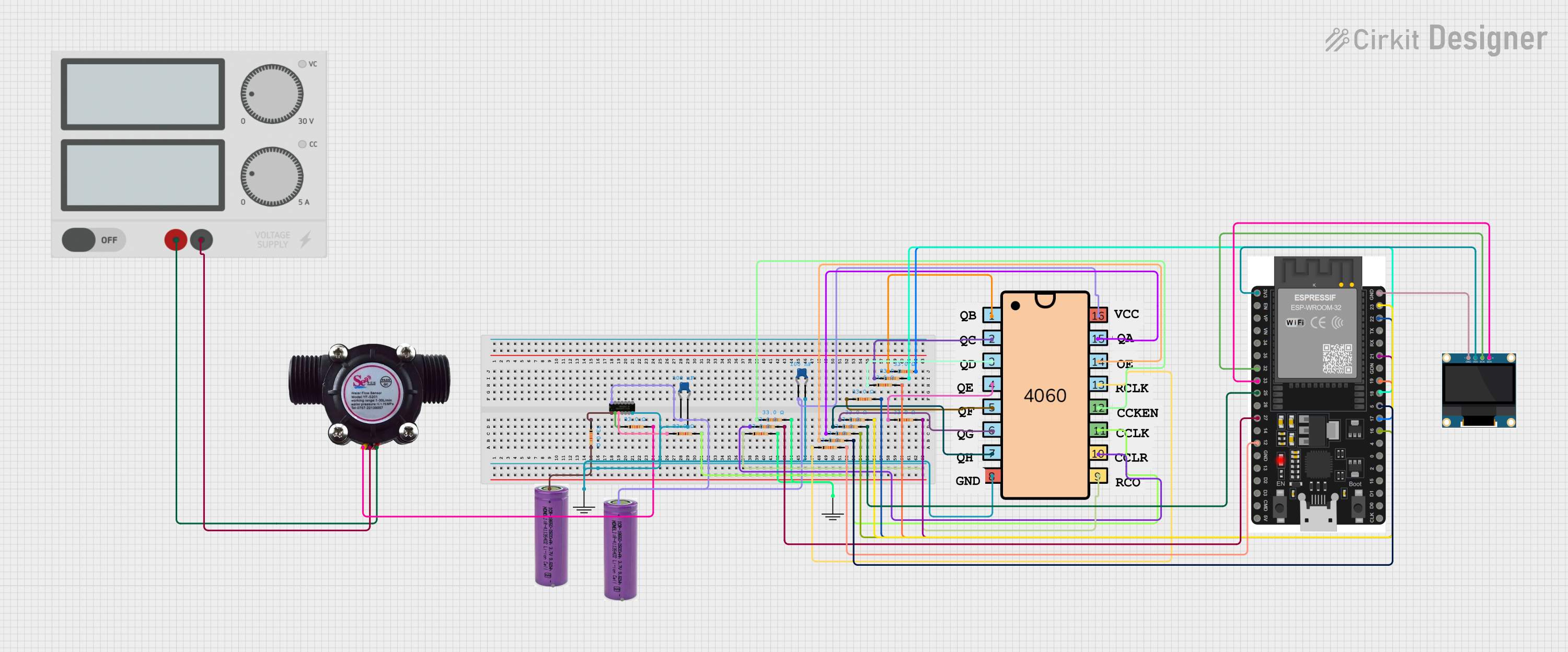
ESP32-Based Water Flow Monitoring System with OLED Display

Circuit Documentation
Summary
The circuit in question appears to be designed for sensing water flow and displaying data on an OLED screen, with the ESP32 microcontroller serving as the central processing unit. The circuit includes a 4060 binary counter, a water flow sensor, a power supply, a level shifter (SN74AHCT125N), two 3.3V batteries, and various resistors and capacitors for signal conditioning and power stabilization. The ESP32 is interfaced with the OLED display for visual output and with the water flow sensor for input. The 4060 binary counter is likely used for timing or frequency division purposes.
Component List
Integrated Circuits
- 4060 Binary Counter: A 14-stage ripple-carry binary counter/divider and oscillator.
- SN74AHCT125N Level Shifter: A quadruple bus buffer gate with 3-state outputs that is used for voltage level translation.
- ESP32 38 PINS: A microcontroller with Wi-Fi and Bluetooth capabilities, used as the main processing unit.
Sensors
- Water Flow Sensor: A device that measures the flow rate of water passing through it, providing a signal output.
Display
- 0.96" OLED: A small display that is likely used to show water flow readings or other status information.
Power Supply Components
- Power Supply: Provides a stable voltage source for the water flow sensor.
- 3.3v Batteries: Two batteries that provide power to the circuit.
Passive Components
- Resistors: Multiple resistors with a resistance of 33 Ohms, likely used for current limiting or pull-up/pull-down configurations.
- Ceramic Capacitors: Capacitors with a capacitance of 0.1 µF, probably used for decoupling and noise reduction on power lines.
Connectors
- GND: Ground reference points for the circuit.
Wiring Details
4060 Binary Counter
- Pin 16: Connected to 3.3V battery.
- Pin 8: Connected to GND.
- Pins 9, 10, 11, 12, 13, 14, 15, 6, 7, 5, 4, 3, 2, 1: Connected to various resistors.
Water Flow Sensor
- Signal: Connected to a resistor.
- Vcc: Connected to the positive terminal of the Power Supply.
- GND: Connected to the negative terminal of the Power Supply.
Power Supply
- +: Connected to the Vcc of the water flow sensor.
- -: Connected to the GND of the water flow sensor.
SN74AHCT125N Level Shifter
- 1OE: Connected to a 3.3V battery.
- 1A: Connected to a resistor.
- 1Y: Connected to a resistor.
- Vcc: Connected to a 3.3V battery.
- GND: Connected to GND.
ESP32 38 PINS
- Various GPIOs: Connected to resistors.
- GND: Connected to the GND of the OLED display.
- 3V3: Connected to the VDD of the OLED display.
- GPIOs 32, 33: Connected to the SCK and SDA of the OLED display, respectively.
0.96" OLED
- GND: Connected to the GND of the ESP32.
- VDD: Connected to the 3V3 of the ESP32.
- SCK: Connected to GPIO 32 of the ESP32.
- SDA: Connected to GPIO 33 of the ESP32.
Resistors
- Multiple instances of 33 Ohm resistors are used throughout the circuit, connected between various IC pins and power lines.
Ceramic Capacitors
- Two 0.1 µF capacitors are connected between the positive and GND lines, likely for power stabilization.
Documented Code
No code was provided for the microcontroller. Typically, the code would be responsible for initializing the peripherals (such as the OLED display and the water flow sensor), reading sensor data, processing the data, and displaying the results on the OLED screen. It would also handle any communication protocols if the ESP32 is used to send data wirelessly.